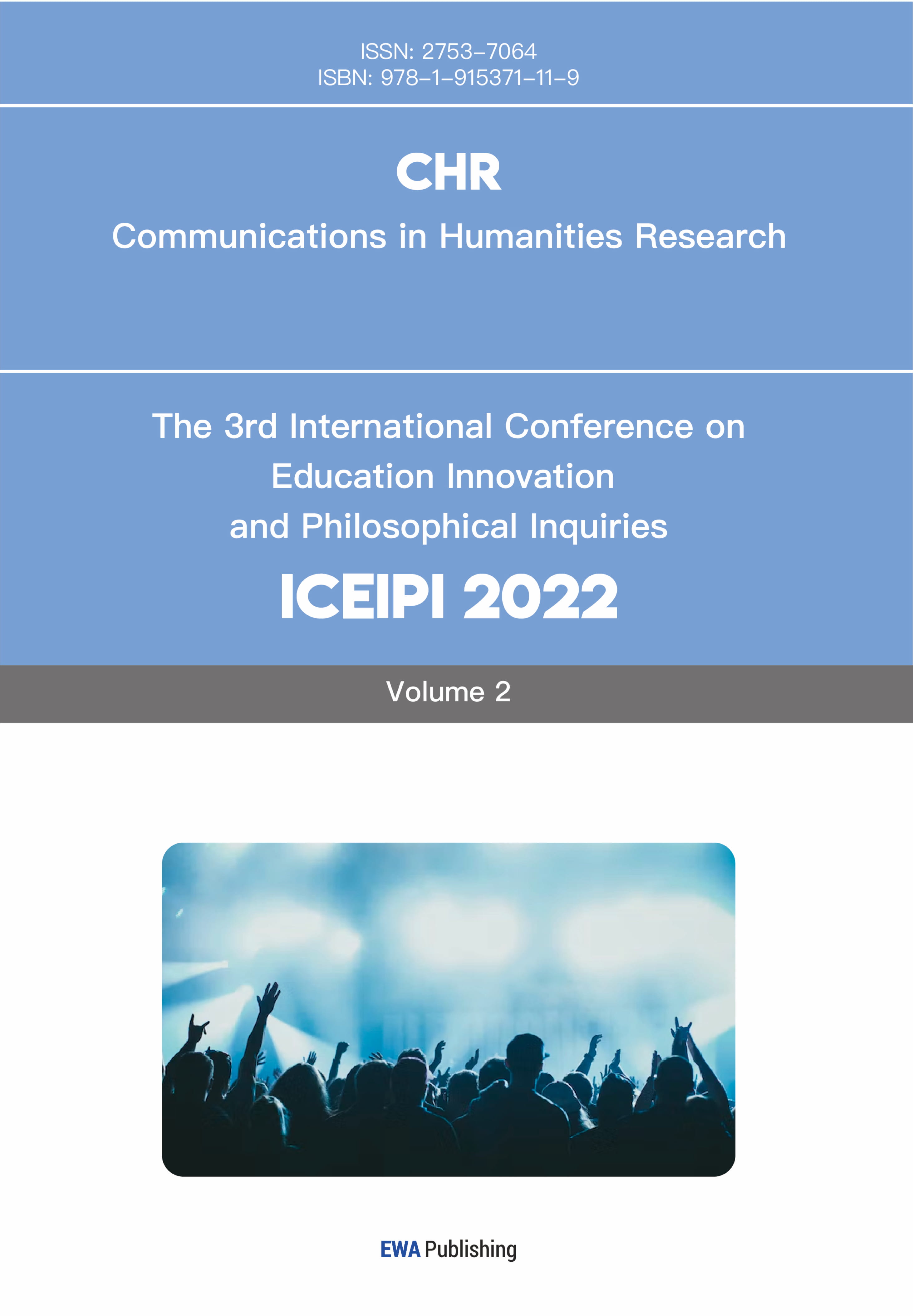References
[1]. A. Chan, “Laozi,” Stanford Encyclopedia of Philosophy, 21-Sep-2018. [Online]. Available: https://plato.stanford.edu/entries/laozi/#DatAutLao. [Accessed: 17-Jun-2022].
[2]. K. Seeskin, “Maimonides,” Stanford Encyclopedia of Philosophy, 04-Feb-2021. [Online]. Available: https://plato.stanford.edu/entries/maimonides/. [Accessed: 17-Jun-2022].
[3]. “Philosophical and religious taoism,” Caroline Myss. [Online]. Available: https://www.myss.com/free-resources/world-religions/taoism/philosophical-and-religious-taoism/. [Accessed: 17-Jun-2022].
[4]. C. Hansen, “Daoism,” Stanford Encyclopedia of Philosophy, 28-Jun-2007. [Online]. Available: https://plato.stanford.edu/entries/daoism/. [Accessed: 17-Jun-2022].
[5]. L. Tze, “Tao Te Ching,” Google Books, 07-Jul-1997. [Online]. Available: https://books.google.com/books/about/Tao_Te_Ching.html?id=u_4kAwAAQBAJ. [Accessed: 17-Jun-2022].
[6]. Q. Wang, “The Unification and Separation of ‘Tao’ and ‘Name’--An Examination of the Text of ‘Laozi - Chapter 1’ on Silk manuscript.” [Online]. Available: https://kns.cnki.net/kcms/detail/detail.aspx?FileName=HZWZ202210068&DbName=CJFQTEMP. [Accessed: 17-Jun-2022]. (In chinese)
[7]. M. Maimonides and S. Pines, The Guide of the Perplexed, Volume 1. Chicago, IL: University of Chicago Press, 2010.
[8]. M. Maimonides, S. Pines, and L. Strauss, The guide of the perplexed. Volume II. Chicago: University of Chicago Press, 1963.
[9]. Figure 2“Humankind - religion guide,” Neoseeker. [Online]. Available: https://www.neoseeker.com/humankind/Religion_Guide. [Accessed: 17-Jun-2022].
[10]. Q. Ma, “CNKI Express 2.0 (KNS8.0) User Experience Bulletin,” "One life gives birth to two, two gives birth to three" -- Xiong Shili Lao "Yi" Relationship Exploration. [Online]. Available: https://kns.cnki.net/kcms/detail/detail.aspx?FileName=ZHLA202103012&DbName=CCJDTEMP. [Accessed: Mar-2021]. (In Chinese)
[11]. “The blind man and the Elephant by John Godfrey Saxe,” by John Godfrey Saxe - Famous poems, famous poets. - All Poetry. [Online]. Available: https://allpoetry.com/The-Blind-Man-And-The-Elephant. [Accessed: 17-Jun-2022].
[12]. “centertao” CenterTaoorg. [Online]. Available: https://www.centertao.org/essays/tao-te-ching/dc-lau/chapter-5-commentary/. [Accessed: 17-Jun-2022].
[13]. H. Niu and Y. Zhang, “Application of electrical automation in solar photovoltaic power generation,” An analysis of the "benevolence" of "unkindness" in Laozi. [Online]. Available: https://kns.cnki.net/kcms/detail/detail.aspx?FileName=JLGB201702014&DbName=CJFQ2017. [Accessed: 15-Feb-2017].
Cite this article
Xue,Y. (2023). The Tacit Understanding Between the Ancient Religions of the West and the Ancient Cultures of China. Communications in Humanities Research,4,13-20.
Data availability
The datasets used and/or analyzed during the current study will be available from the authors upon reasonable request.
Disclaimer/Publisher's Note
The statements, opinions and data contained in all publications are solely those of the individual author(s) and contributor(s) and not of EWA Publishing and/or the editor(s). EWA Publishing and/or the editor(s) disclaim responsibility for any injury to people or property resulting from any ideas, methods, instructions or products referred to in the content.
About volume
Volume title: Proceedings of the International Conference on Interdisciplinary Humanities and Communication Studies (ICIHCS 2022), Part 2
© 2024 by the author(s). Licensee EWA Publishing, Oxford, UK. This article is an open access article distributed under the terms and
conditions of the Creative Commons Attribution (CC BY) license. Authors who
publish this series agree to the following terms:
1. Authors retain copyright and grant the series right of first publication with the work simultaneously licensed under a Creative Commons
Attribution License that allows others to share the work with an acknowledgment of the work's authorship and initial publication in this
series.
2. Authors are able to enter into separate, additional contractual arrangements for the non-exclusive distribution of the series's published
version of the work (e.g., post it to an institutional repository or publish it in a book), with an acknowledgment of its initial
publication in this series.
3. Authors are permitted and encouraged to post their work online (e.g., in institutional repositories or on their website) prior to and
during the submission process, as it can lead to productive exchanges, as well as earlier and greater citation of published work (See
Open access policy for details).
References
[1]. A. Chan, “Laozi,” Stanford Encyclopedia of Philosophy, 21-Sep-2018. [Online]. Available: https://plato.stanford.edu/entries/laozi/#DatAutLao. [Accessed: 17-Jun-2022].
[2]. K. Seeskin, “Maimonides,” Stanford Encyclopedia of Philosophy, 04-Feb-2021. [Online]. Available: https://plato.stanford.edu/entries/maimonides/. [Accessed: 17-Jun-2022].
[3]. “Philosophical and religious taoism,” Caroline Myss. [Online]. Available: https://www.myss.com/free-resources/world-religions/taoism/philosophical-and-religious-taoism/. [Accessed: 17-Jun-2022].
[4]. C. Hansen, “Daoism,” Stanford Encyclopedia of Philosophy, 28-Jun-2007. [Online]. Available: https://plato.stanford.edu/entries/daoism/. [Accessed: 17-Jun-2022].
[5]. L. Tze, “Tao Te Ching,” Google Books, 07-Jul-1997. [Online]. Available: https://books.google.com/books/about/Tao_Te_Ching.html?id=u_4kAwAAQBAJ. [Accessed: 17-Jun-2022].
[6]. Q. Wang, “The Unification and Separation of ‘Tao’ and ‘Name’--An Examination of the Text of ‘Laozi - Chapter 1’ on Silk manuscript.” [Online]. Available: https://kns.cnki.net/kcms/detail/detail.aspx?FileName=HZWZ202210068&DbName=CJFQTEMP. [Accessed: 17-Jun-2022]. (In chinese)
[7]. M. Maimonides and S. Pines, The Guide of the Perplexed, Volume 1. Chicago, IL: University of Chicago Press, 2010.
[8]. M. Maimonides, S. Pines, and L. Strauss, The guide of the perplexed. Volume II. Chicago: University of Chicago Press, 1963.
[9]. Figure 2“Humankind - religion guide,” Neoseeker. [Online]. Available: https://www.neoseeker.com/humankind/Religion_Guide. [Accessed: 17-Jun-2022].
[10]. Q. Ma, “CNKI Express 2.0 (KNS8.0) User Experience Bulletin,” "One life gives birth to two, two gives birth to three" -- Xiong Shili Lao "Yi" Relationship Exploration. [Online]. Available: https://kns.cnki.net/kcms/detail/detail.aspx?FileName=ZHLA202103012&DbName=CCJDTEMP. [Accessed: Mar-2021]. (In Chinese)
[11]. “The blind man and the Elephant by John Godfrey Saxe,” by John Godfrey Saxe - Famous poems, famous poets. - All Poetry. [Online]. Available: https://allpoetry.com/The-Blind-Man-And-The-Elephant. [Accessed: 17-Jun-2022].
[12]. “centertao” CenterTaoorg. [Online]. Available: https://www.centertao.org/essays/tao-te-ching/dc-lau/chapter-5-commentary/. [Accessed: 17-Jun-2022].
[13]. H. Niu and Y. Zhang, “Application of electrical automation in solar photovoltaic power generation,” An analysis of the "benevolence" of "unkindness" in Laozi. [Online]. Available: https://kns.cnki.net/kcms/detail/detail.aspx?FileName=JLGB201702014&DbName=CJFQ2017. [Accessed: 15-Feb-2017].









